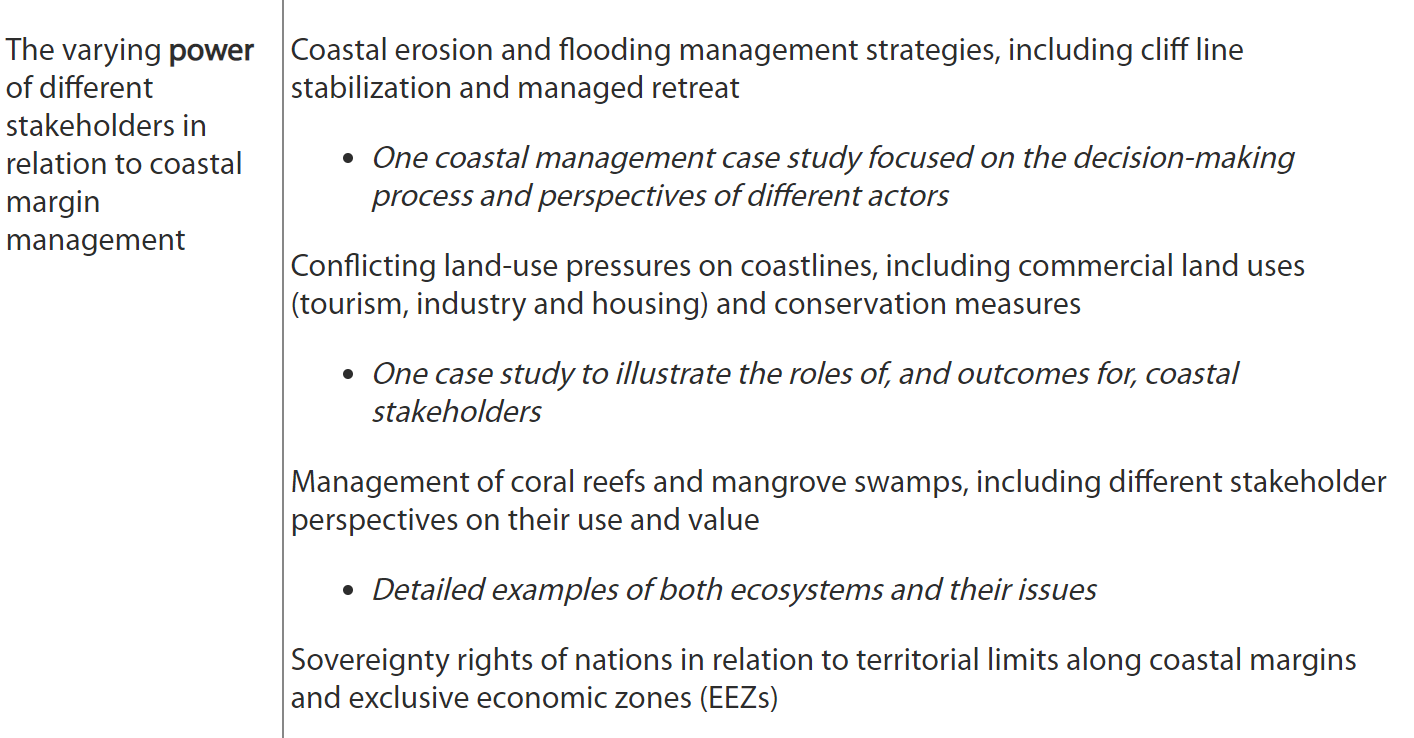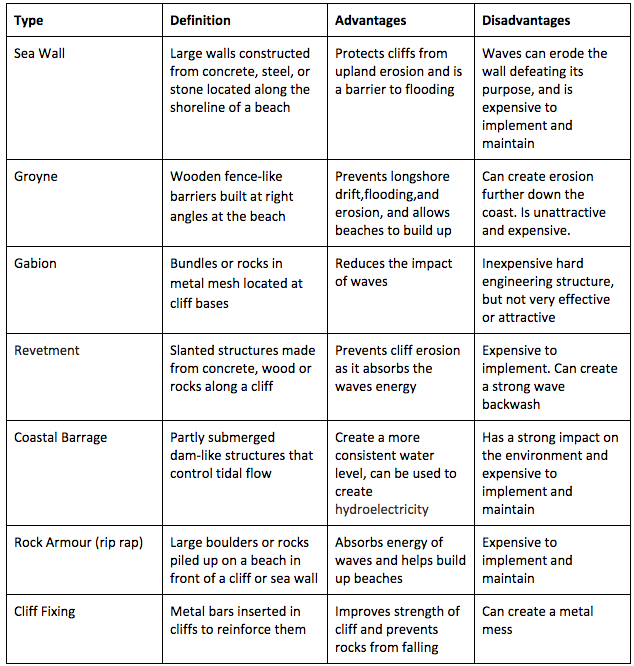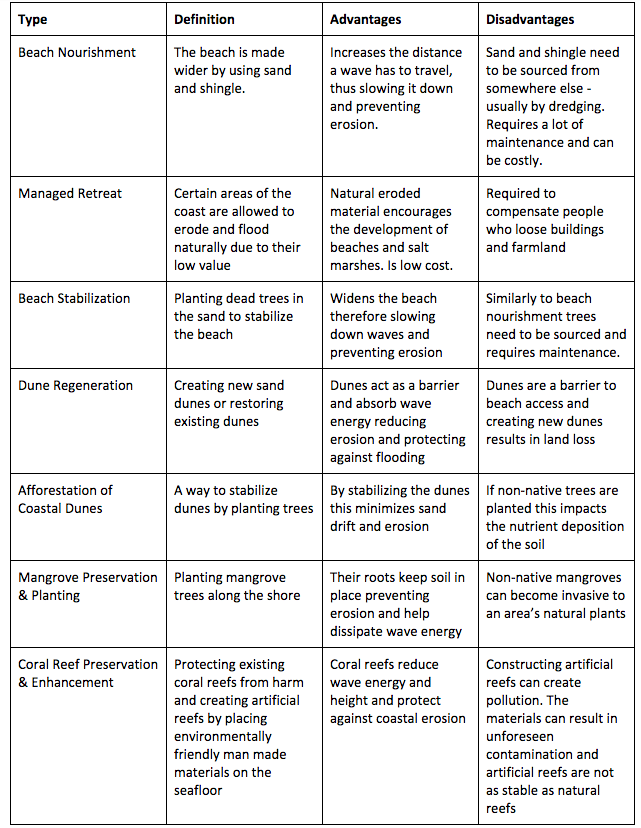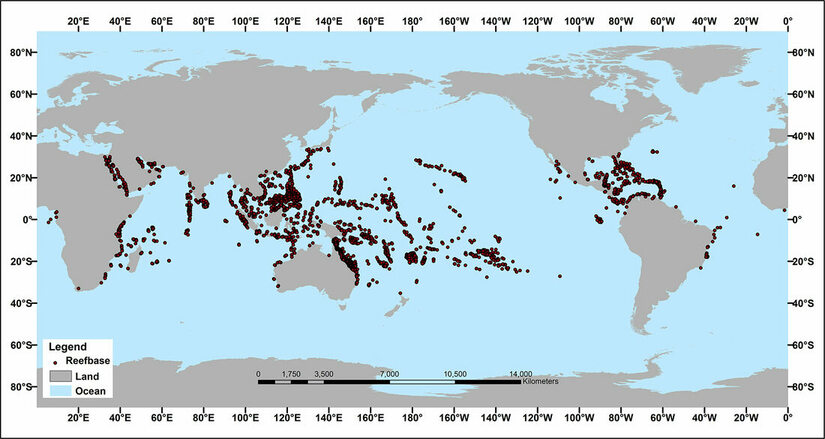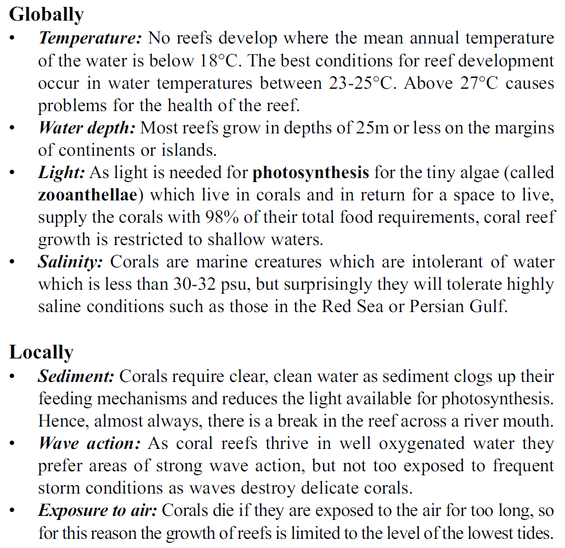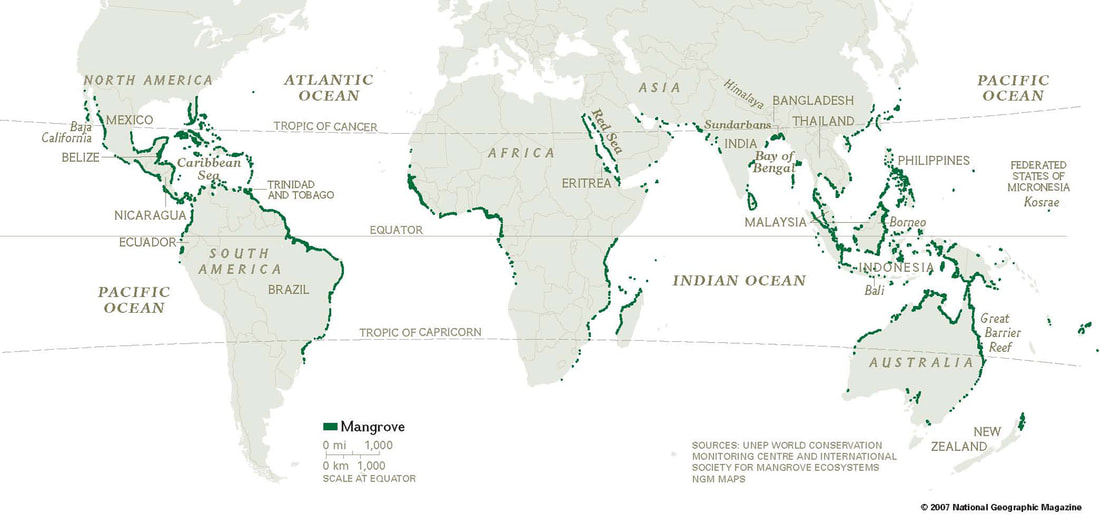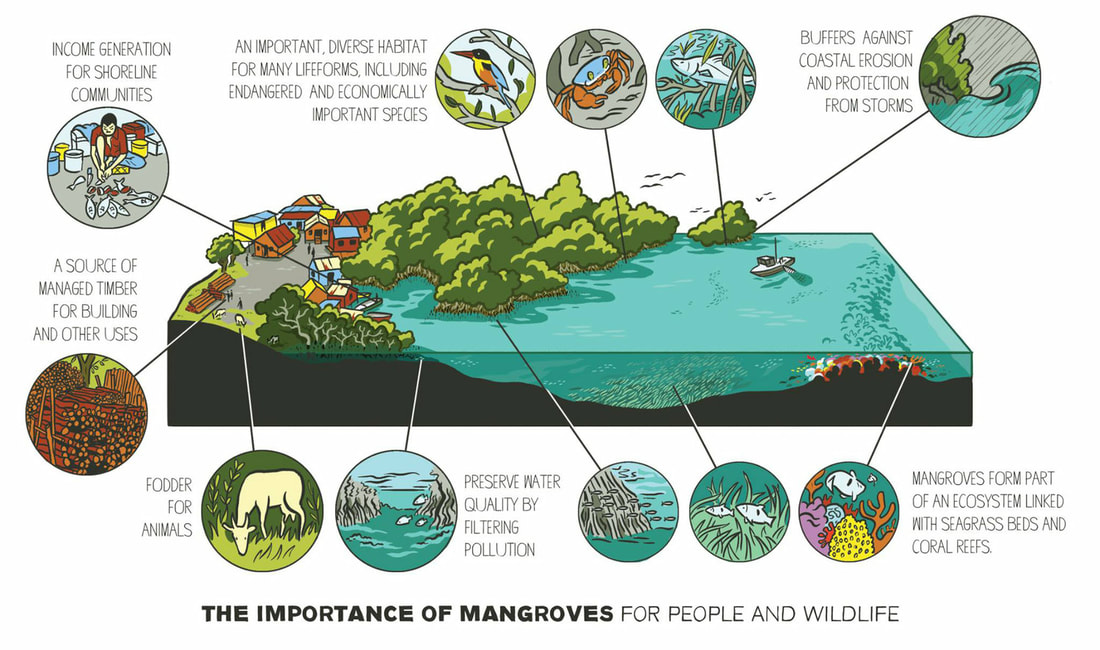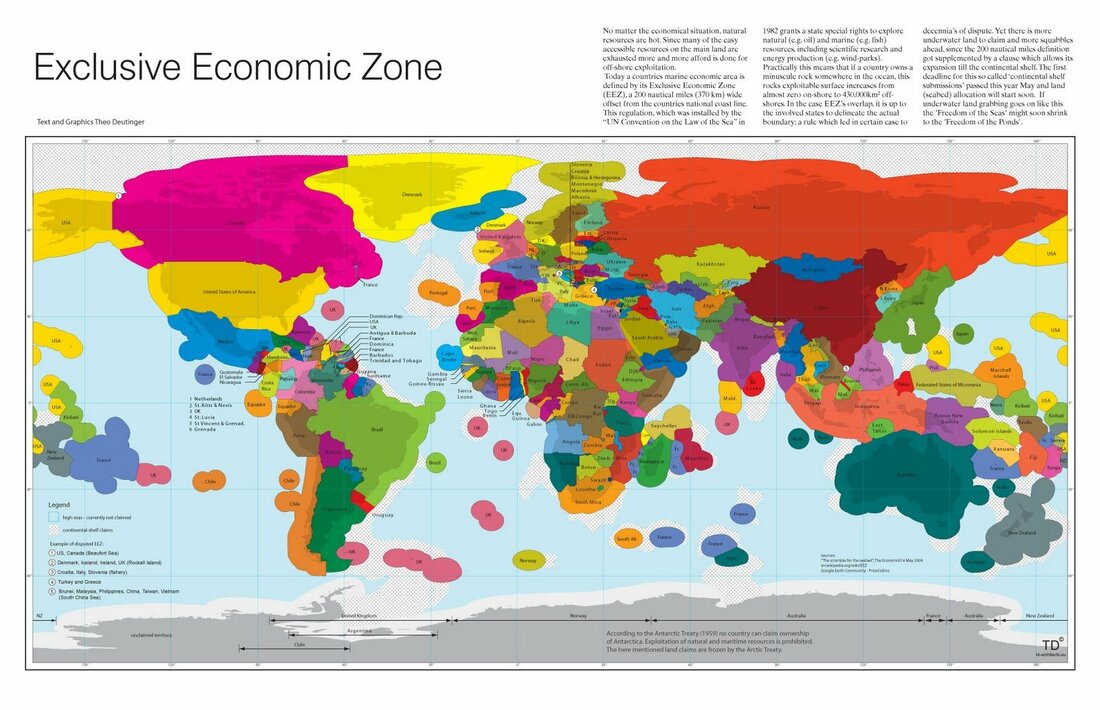Coastal Management Strategies
Hard EngineeringHard engineering is a coastal management technique used to protect coasts,by absorbing the energy of waves, preventing erosion and flooding. They are highly visible man-made structures used to stop or disrupt natural processes. These structures are expensive,short-term solutions and often they can have a negative impact on the environment. Installing hard engineering structures in one coastal location can have detrimental effects further down the coast.
|
Soft EngineeringSoft engineering works with nature to protect the coast rather than trying to stop natural processes. It uses ecological principles and practises, therefore making less of a negative impact on the natural environment. Soft engineering is less expensive to implement and maintain, and creates more long-term, sustainable solutions than hard engineering projects.
|
Your browser does not support viewing this document. Click here to download the document.
| Coastal Management | |
| File Size: | 497 kb |
| File Type: | |
|
|
|
- Explain why building sea walls can be a negative as well as a positive management strategy.
- List the coastal management strategies described in this section. For each management strategy, state a benefit and a shortcoming of the strategy.
- Why are coastal management strategies likely to be different in richer societies compared with poorer societies?
Your browser does not support viewing this document. Click here to download the document.
| coastal_management_in_selsey.pdf | |
| File Size: | 1449 kb |
| File Type: | |
|
|
|
|
Conflicting land-use pressures on coastlines
Your browser does not support viewing this document. Click here to download the document.
| resolving_resource_use_conflicts_in_coastal_zones.pdf | |
| File Size: | 290 kb |
| File Type: | |
Your browser does not support viewing this document. Click here to download the document.
| multiple_use_of_coastal_zones.docx | |
| File Size: | 159 kb |
| File Type: | docx |
Your browser does not support viewing this document. Click here to download the document.
| coastal_stakeholders.pdf | |
| File Size: | 993 kb |
| File Type: | |
Coral Reefs
|
What is coral?
Coral reefs are some of the most diverse ecosystems in the world. Coral polyps, the animals primarily responsible for building reefs, can take many forms: large reef building colonies, graceful flowing fans, and even small, solitary organisms. Thousands of species of corals have been discovered; some live in warm, shallow, tropical seas and others in the cold, dark depths of the ocean. |
|
|
| ||||||||||||
Mangrove Forests
|
A mangrove is a shrub or small tree that grows in coastal saline or brackish water. The term is also used for tropical coastal vegetation consisting of such species. Mangroves occur worldwide in the tropics and subtropics, mainly between latitudes 25° N and 25° S. The total mangrove forest area of the world in 2000 was 137,800 square kilometres (53,200 sq mi), spanning 118 countries and territories.
Mangroves are salt-tolerant trees, also called halophytes, and are adapted to life in harsh coastal conditions. They contain a complex salt filtration system and complex root system to cope with salt water immersion and wave action. They are adapted to the low oxygen conditions of waterlogged mud. Like coral reefs, mangrove forests are extremely productive ecosystems that provide numerous good and services both to the marine environment and people. According to a recent report, these goods and services are conservatively estimated to be worth US$186 million each year. They include:
|
|
|
| ||||||||||||
Exclusive Economic Zones (EEZ)
Economic Exclusive Zone (EEZ)
A maritime zone adjacent to the territorial sea that may not extend beyond 200 nautical miles from the baselines from which the breadth of the territorial sea is measured. Within the exclusive economic zone (EEZ), the coastal state has sovereign rights for the purpose of exploring, exploiting, conserving, and managing natural resources, both living and nonliving, of the seabed, subsoil, and the subjacent waters and, with regard to other activities, for the economic exploitation and exploration of the zone (e.g., the production of energy from the water, currents, and winds).
EEZ and Conflict (Wikipedia links)
The exact extent of exclusive economic zones is a common source of conflicts between states over marine waters.
A maritime zone adjacent to the territorial sea that may not extend beyond 200 nautical miles from the baselines from which the breadth of the territorial sea is measured. Within the exclusive economic zone (EEZ), the coastal state has sovereign rights for the purpose of exploring, exploiting, conserving, and managing natural resources, both living and nonliving, of the seabed, subsoil, and the subjacent waters and, with regard to other activities, for the economic exploitation and exploration of the zone (e.g., the production of energy from the water, currents, and winds).
EEZ and Conflict (Wikipedia links)
The exact extent of exclusive economic zones is a common source of conflicts between states over marine waters.
- One well-known example of such dispute was the Cod Wars between the United Kingdom and Iceland.
- Norway and Russia dispute both territorial sea and EEZ with regard to the Svalbard archipelago as it affects Russia's EEZ due to its unique treaty status. A treaty was agreed in principle in April 2010 between the two states and subsequently ratified, resolving this demarcation dispute.[7] The agreement was signed in Murmansk on September 15, 2010.[8]
- The dispute over Rockall is mainly due to its effect on EEZ, not on its resources or strategic benefits.
- The South China Sea (and the Spratly Islands) is the site of an ongoing dispute between several neighboring nations.
- Croatia's ZERP (Ecological and Fisheries Protection Zone) in the Adriatic Sea caused friction with Italy and Slovenia, and caused problems during Croatia's accession to the European Union.
- A wedge-shaped section of the Beaufort Sea is disputed between Canada and the United States, as the area reportedly contains substantial oil reserves.
- France claims a portion of Canada's EEZ for Saint-Pierre-et-Miquelon based on a new definition of the continental shelf and EEZ between the two countries. Saint-Pierre-et-Miquelon is entirely surrounded by Canada's EEZ.
- Mauritius claims EEZ for Tromelin from France and EEZ for British Indian Ocean Territory from the UK.
- Northern Cyprus claims a portion of Cyprus' EEZ overlaps with that of Northern Cyprus in the south/southeastern part of the Cyprus island.[9]
- Cyprus claims a portion of Turkey's EEZ overlaps with its own EEZ.[10]
- Lebanon claims that the agreement between Cyprus and Israel overlapped its own EEZ.
